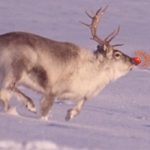Rúdolf an Réinfhia – Redux (Cuid a hAon, 1/3) Posted by róislín on Dec 15, 2011 in Irish Language
(le Róislín)
 As some of you may recall, we did a Rudolph questionnaire in this blog cúpla Nollaig ó shin. With so many new readers, I thought I’d do a new revised version of it. If you check the original (https://blogs.transparent.com/irish/ceistiuchan-faoi-rudolf-an-reinfhia/), you’ll see I am making some athruithe beaga and adding some nótaí maidir le fuaimniú. So I’ll actually split the original ceistiúchán in two, since otherwise it would be rófhada [ROH-AH-duh].
As some of you may recall, we did a Rudolph questionnaire in this blog cúpla Nollaig ó shin. With so many new readers, I thought I’d do a new revised version of it. If you check the original (https://blogs.transparent.com/irish/ceistiuchan-faoi-rudolf-an-reinfhia/), you’ll see I am making some athruithe beaga and adding some nótaí maidir le fuaimniú. So I’ll actually split the original ceistiúchán in two, since otherwise it would be rófhada [ROH-AH-duh].
Pronunciation reminder: the “fh” in “réinfhia” and “réinfhianna” is silent [RAYN-EE-uh; RAYN-EE-uh-nuh]. But the “f” in the basic word, “fia” (deer) is pronounced [FEE-uh].
Seo an réamhrá [rayv-raw] bunúsach:
We all probably know the song about Rudolph. But can you answer these questions about him in Irish? Answers below, together with a short glossary [níos faide anois mar gheall ar an nuashonrúchán].
1..Cén sórt “fia” é Rúdolf? a) fia fionn (buí) b) fia Baictriach c) muscfhia [MUSK-EE-uh] d) carabú (An focheist anseo, is dócha, an “fia” é Rúdolf? Ach sin ábhar eile!)
2. Cén dath atá ar shrón Rúdolf? a) rua b) flannbhuí [flan-wee] c) flanndearg d) dearg [DJAR-ug] (N.B. “flann” is “blood-red” color, or when applicable, “sanguinary”)
3. An bhfaca [WAH-kuh] tú riamh réinfhia deargshrónach (i. ceann beo / fíorcheann)?
a) chonaic b) ní fhaca [AH-kuh]
4. Dá bhfeicfeá [VEK-haw] réinfhia deargshrónach, cad a dhéanfá [YAYN-haw]?
a) Ghlacfainn grianghraf de b) Dhíolfainn [YEEL-hin] le sorcas é
c) Ghlaofainn ar Dhaidí na Nollag le rá go raibh a réinfhia ar strae
5. Cén sórt pearsantachta atá ag na réinfhianna eile?
a) deas b) dána c) mínormalach [MEE-NOR-mal-ukh]
6. Céard a dhéanann na réinfhianna eile?
a) Bíonn siad ag súgradh le Rúdolf. b) Bíonn siad ag magadh faoi Rúdolf.
7. Ar lig siad do Rúdolf a bheith ag súgradh leo? a) lig b) níor lig
8. Cén oíche a bhí ann? a) Oíche Nollag b) Oíche Lá Nollag c) Oíche Chinn Bhliana
9. Cé a tháinig? a) San Proinsias Assisi b) San Críostóir c) San Nioclás, i.e. Daidí na Nollag (N.B. “San” is used for most non-Irish saints and “naomh” for Irish saints, m.sh. Pádraig)
10. Cad a d’iarr sé ar Rúdolf? a) a shleamhnán a tharraingt [uh HLOW-nawn uh HAR-inch] b) báirseoireacht [BAWR-shor-ukht] a dhéanamh ar na réinfhianna eile
By the way, lately I’ve noticed a lot of references online to Rudolph as being “dearg-nosed,” using a hybrid Irish-English word. I can’t say that I’ve ever heard anyone use this word in real life, anymore than I’ve ever heard anyone say “red-srónach.” Or would that be “red-shrónach.” Hmmm, would the d-n-t-l-s rule actually apply if the first part of the word is English? At any rate, a lot of these sites also refer to “A Brown Charlie Nollag” [sic, yes, exactly like that, which doesn’t really make sense in either language – why put “Brown” before “Charlie” and why change “Nollaig” to “Nollag,” (putting it into the genitive case)? If “Charlie Brown,” or even “Brown Charlie” is meant to be an adjective, or a possessor, it should come after “Nollaig.” Aistrithe ag meaisín, b’fhéidir?] Aisteach, nach ea? (Strange, isn’t it?)
But speaking of ways of describing noses, deer or otherwise, the remaining part of the questionnaire will be in the next blog. We’ll talk about types ranging from “bánsrónach” to “sciansocach,” and where you might find them. Maybe even a little “Sleeper” digression! Srón fána sciála?
Go dtí sin, SGF, Róislín
Freagraí: 1d, 2d, 3 & 4 do rogha féin, 5b, 6b, 7b, 8a, 9c, 10a
Gluais: fionn, buí, fallow (tawny or buff-colored when talking about deer; usually “fionn” means “blond” or “fair” and “buí” is “yellow,” or sometimes “orange”); dath, color; riamh [REE-uv] ever; grianghraf [GREE-un-γraf] photograph; go raibh X, that X was; mínormalach, abnormal; súgradh, playing; magadh faoi, making fun of; d’iarr, asked; tarraingt, pulling; sleamhnán, sleigh, also: slide, runner, sliding part; báirseoireacht, scolding; aistrithe ag, translated by; fána, slope
Nóta/ceist faoi a) Oíche Nollag, b) Oíche Lá Nollag, agus c) Oíche Chinn Bhliana: an féidir leat iad a mheaitseáil leis na dátaí?
25 Mí na Nollag = b (the night of Christmas day)
31 Mí na Nollag = c (the night of the end of the year)
24 Mí na Nollag = a (the eve of Christmas)
Nóta eile: briathra sa mhodh coinníollach
Dá bhfeicfeá, if you would see; cad a dhéanfá, what would you do?; ghlacfainn, I would take; dhíolfainn, I would sell; ghlaofainn, I would call

Build vocabulary, practice pronunciation, and more with Transparent Language Online. Available anytime, anywhere, on any device.




Leave a comment: